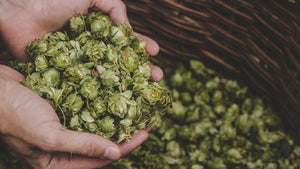Since we have previously gone through Malt; one of four main ingredients of beer brewing, it’s about time we drop another blog, and this time on the all time favourite hoppity hoppity hop!
One of the common phrases we often hear from newbie craft beer drinkers is “I want IPA, but I don’t want so bitter one can or not uh?” Then my mind goes blank for a few seconds with my eyes rolled up, and nothing but “ehhhhhhhhhh….” comes out from my mouth after my brain decides to finally work.
But this is beer for noobs right, so we have to go back to basics. Hops are these funky little cone-shaped flowers of the vine-like plant, scientists and other fancy people call them humulus lupulus. These little suckers are a close relative to cannabis and contain acids and oils that impart bitterness, flavour and more importantly, to balance out the sweetness from the malt.

During the brewing process, hops are added at the beginning of the boiling stage as a bittering agent and more are added at the end of the boil for aroma and flavour (also known as Dry Hopping). Hops also act as a preservative by inhibiting spoilage bacteria during a beer’s shelf life and they help to stabilise foam.
Generally there are two kinds of hops: bittering hops, which have a higher alpha acid content and contribute more bitterness but tend to impart a less refined flavour and aroma; and aroma hops, which are lower in alpha acids, but contribute desirable flavour and aroma characteristics. Some hops are dual-purpose.
While there are hundreds of different varieties of hops, let’s take some time to look at some of the common ones that are used in craft beer.
Cascade hops are often used to create citrusy notes, often described as having a grapefruit-like character, and have distinct floral notes. Cascade set the stage for a whole wave of fruity, citrusy, tropical flavours that are very common in American IPAs.
Mosaic is another commonly seen one. This particular hop burst onto the craft beer scene in 2012 with high alpha acids and its popularity stems from the complex “mosaic” of aromas it offers such as tropical fruit, citrus, berry, pine, grass, spice and more. Mosaic can be found in just about any style today, though it is most often used in IPAs and Pale Ales.
To keep this blog simple and easy to digest, we’ll just keep it to two examples. At AMLT, we love ourselves some fragrant, dank and hop forward IPAs. Check out our curated selection of hoppy goodness here!
So to all you beer noobs out there, please stop saying you want an IPA but not so bitter or worse still, not bitter at all. Learn to enjoy the unapologetic yet pleasant bitterness that a beer can bring to you. It’s like how people enjoy eating bitter gourd, kind of the same logic. Regardless, one good way to know how hops have been used in a particular beer is checking the IBU level. An increasing number of beers will display the IBU, or “International Bittering Units,” which measures the iso-alpha acids in a beer (and thus, the bitterness). But whether you notice them or not, if you’re drinking beer, you’re reaping the benefits of the hops plant.

